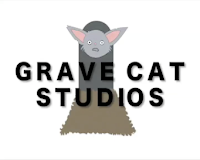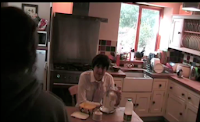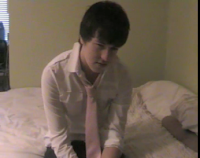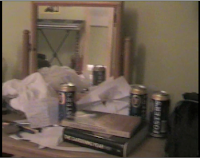Our group consists of Sam Gillard, Will Hooper, Harry Flook and Bryn Evans. The blog presents our project and all related work.
Friday, 26 March 2010
Tuesday, 23 March 2010
Looking back at your preliminary task, what do you feel you have learnt in the progression from it to the full product?
- Our knowledge of Final Cut Pro and Soundtrack Pro has become greater and we have become more fluent in how we use it.


- We have realized the importance of blogging what we have done. It helped us to have a clearer picture of what we need to do and consolidate all the work we had done so far.
- We incorporated the use of Adobe Illustrator and Adobe Photoshop to create a more professional look to our product.
Labels:
Bryn Evans,
Harry Flook,
Sam Gillard,
Will Hooper
What have you learnt about technologies from the process of constructing this product?
During the process of filming and making our opening sequence, we learned:
- How to make animated titles,

- How to become mo
 re efficient with the software such as Soundtrack Pro, Final Cut Pro and LiveType,
re efficient with the software such as Soundtrack Pro, Final Cut Pro and LiveType,
 To use p
To use p rograms like Adobe Illustrator and PhotoShop, and add files made on there onto Final Cut.
rograms like Adobe Illustrator and PhotoShop, and add files made on there onto Final Cut.
- We had some problems with the technology, for example, the microphone did not always pick up the sound (which we had to dub over later).
- We also had difficulties trying to sync the sound and music with the film on Final Cut - this was the only time we needed any help with the process.
Labels:
Bryn Evans,
Harry Flook,
Sam Gillard,
Will Hooper
How did you attract/address your audience?
The topic being discussed would attract a certain audience due to relativity of the topic. It covers current issues and addresses the audience in a way that people in a similar situation can relate to, especially the plot and the main character.

Feedback:
- Feedback was mostly positive, feedback that wasn't positive was, however, constructive towards our final cut.
- We decided to keep the pace of our earlier shots as slow as we did because we felt that that time of day (morning) is not fast-paced, so therefore would not be a true representation of time period.

Labels:
Bryn Evans,
Harry Flook,
Sam Gillard,
Will Hooper
Who would be the audience and why?

- The film would be a 15 certificate, we agreed on this for two reasons:
- The film contains characters in stressful, high-pressure life events, meaning that the language used could be less restrained. There is no reason why we thought it should be higher than a 15 because it would not fit the criteria of an 18 film.
- The topic of unemployment would not have as much relevance, or importance for possible viewers under the age of 15; because many people under 15 do not have a job and the topic might be seen by many young people as 'unappealing'.
- A more specific demographic that might be people who have been recently affected by the economic downturn. Viewers from this category would be more likely to relate to the plight of the main character.
Labels:
Bryn Evans,
Harry Flook,
Sam Gillard,
Will Hooper
What kind of media institution might distribute your media product and why?
- A rarely portrayed film topic, a current, British film about unemployment might be distributed by a more independent film institution, such as Working Title or Pathe.


Labels:
Bryn Evans,
Harry Flook,
Sam Gillard,
Will Hooper
How does your media product represent particular social groups?

It's more
 of a fictional portrayal rather than making a social comment about men of a certain age having a mid-life crisis and it just so happens to be that redundancy is the cause of this.
of a fictional portrayal rather than making a social comment about men of a certain age having a mid-life crisis and it just so happens to be that redundancy is the cause of this.The mise-en-scene as a whole, especially the cans of Fosters and the strewn bits of paper, represents how a man who has just been made redundant can reduce himself to excessive drinking and generally falls into a messy life style.

Labels:
Bryn Evans,
Harry Flook,
Sam Gillard,
Will Hooper
Thursday, 18 March 2010
In what ways does your media product use, develop or challenge forms and conventions of real media products?
Conventions:


- Sound: Mandolin - rarely used for film scores. More background music than dominant and central to the point of the visuals. Creates a mood and atmosphere as opposed to relating to the plot.
- Editing: Reversed plot timeline (starts at the end scene and then goes back in time). Slow shots when the character is on his bed show that he is thinking about his plight. In contrast to the triplets - not seen often, and gives the sequence a more upbeat rhythm, show


 ing that he is happy.
ing that he is happy.
- Cinematography: Zoom in at the beginning - shows the central character, getting closer to him shows the relationship the audience will have with the character. Walking into the character happens at the end - meaning that the plot has gone full-circle.



- Mise-en-scene: Pathetic fallacy used when character is walking to work - captures his positive mood at that time. Untidiness of his room mirrors the untidiness of his mental well-being after he lost his job.
- Plot: Unconventional, yet current and newsworthy topic is being discussed in this film. Because of the unconventionality of the film, it is highly likely that it would get substantial news coverage.
Labels:
Bryn Evans,
Harry Flook,
Sam Gillard,
Will Hooper
Thursday, 11 March 2010
Rough Cut Editing
Over the last week, we started editing the 'rough cut' of our opening sequence. In addition to editing what we had already filmed in Bleadon the previous week, we also had to film a clock, showing the passage of time.
Also, we added the logos of our studio and production companies; we all worked on the Happy Paper Productions logo, and Will and I did the Grave Cat Studios animated logo.
We hope to have the rough cut finished by the end of Thursday's lesson (March 11th).
Tuesday, 2 March 2010
Further Filming
Today we filmed more of our opening sequence including some scenes we decided to re-film:
- Re-filming of the toast triplet.
- Filming of the milk triplet.
- Filming of the scene in which Mark wakes up.
- Filming of the scene in which Drake informs Mark he is late for work.
- Filming of Mark walking into work.
Subscribe to:
Comments (Atom)
Michelle's Blog
Blog Archive
-
▼
2010
(30)
-
▼
March
(10)
- Final Cut
- Looking back at your preliminary task, what do you...
- What have you learnt about technologies from the p...
- How did you attract/address your audience?
- Who would be the audience and why?
- What kind of media institution might distribute yo...
- How does your media product represent particular s...
- In what ways does your media product use, develop ...
- Rough Cut Editing
- Further Filming
-
▼
March
(10)
About Me
- Weston Sixth Form 15.09
- Our group is Sam Gillard, Georgia Wilde and Lauren Holder.

